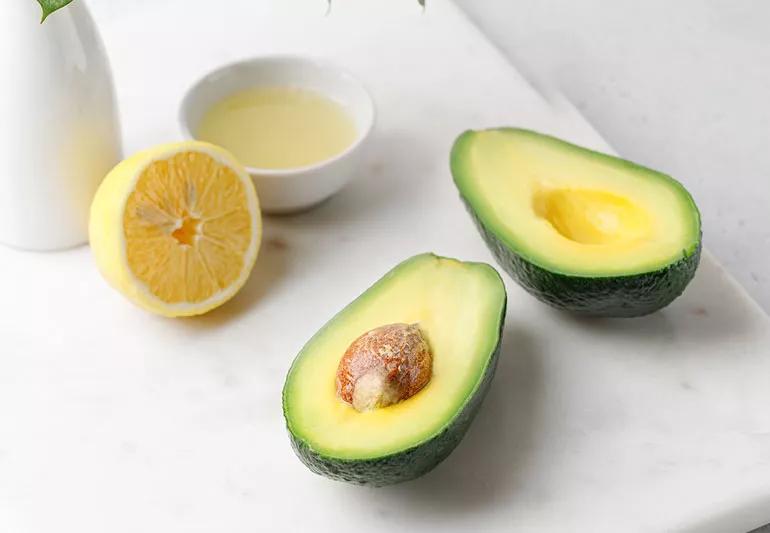Warning: A popular TikTok hack to extend the life of avocados could lead to food poisoning

Avocados may be scrumptiously tasty, but the oh-so-healthy fruit is a notorious source of frustration in the kitchen. It usually takes days of patiently waiting for a rock-hard avocado to ripen — and then, it seems to go from perfection to mushy in mere minutes.
Advertisement
Cleveland Clinic is a non-profit academic medical center. Advertising on our site helps support our mission. We do not endorse non-Cleveland Clinic products or services. Policy
So, how can you extend the useful life of an avocado? That’s just the kind of challenge made for the creative minds on TikTok. And they did not disappoint. (#savetheavocados)
A viral hack promises that avocados can be kept fresh for up to a month if they’re submerged in water and stored in the fridge. Dunk ‘em whole or cut in half! Either way, you’ve got avocados for longer!
If that sounds too good to be true … well, it is. This seemingly helpful TikTok tip might as well be labeled as a how-to guide for potential food poisoning, states registered dietitian Carly Sedlacek, RDN, LD. Here’s why.
To be clear, the answer to this question is a definite NO — an opinion shared widely by the U.S. Food and Drug Administration (FDA) after the avocado storage hack began trending on social media.
It’s not uncommon to find bacteria on the bumpy outer skin of an avocado. An FDA study detected Listeria monocytogenes on nearly 18% of tested fruit. Salmonella popped up on 0.74% of sampled avocados.
But wait! It gets worse! FDA researchers also found that keeping avocados in water allowed Listeria monocytogenes to permeate the fleshy pulp beneath the skin in some cases. (Even washing the avocado won’t help at that point.)
Advertisement
“If you put your avocado in water, you’re really just dropping it into a breeding ground for any bacteria that are present,” says Sedlacek. “This TikTok hack is a recipe for foodborne illness. It’s very, very bad.”
Both types of bacteria can cause gastrointestinal mayhem such as diarrhea, stomach cramps, nausea and other rather unpleasant symptoms.
You just returned home from the grocery store with a bag filled with firm avocados. Where should you put them to ripen? “Your best bet is to leave them out on the counter,” advises Sedlacek.
But make sure to check your avocados daily. (Remember, they can turn ripe in a jiffy!) Signs that an avocado is ready to eat include:
Once your avocado is ready to eat, placing it in the refrigerator can slow the ripening process. “That can buy you an extra day or two — but don’t wait too long to use it,” says Sedlacek.
Don’t fear if you only used half an avocado this morning while making a slice of avocado toast. You’ll be able to enjoy the rest of the fruit with tomorrow’s breakfast if you take a few storage steps.
The creamy pulp of an avocado tends to gain unappetizing brown spots once exposed to the outside world. An enzyme in the fruit creates these splotches upon contact with air and oxygen.
Take these steps to slow down that oxidation process and keep your avocado fresh.
Advertisement
Avocados aren’t the easiest fruit around when it comes to preparation. That tough exterior skin needs to be removed, for starters. Then, there’s the matter of extricating that pesky pit in the middle.
The task requires some deft work with a knife. Not everyone is up to the undertaking.
Avocado-related knife injuries send thousands of Americans to emergency rooms every year, studies show. It’s become so common, there’s even a name for the self-inflicted wound — “avocado hand.”
To keep your fingers and hands intact, follow these guidelines:
One more thing, too: Make sure to wash your avocado thoroughly before cutting into it. “If there is any bacteria on the skin when you cut into it, all you’re going to do is shove that bacteria inside to what you’re going to eat,” stresses Sedlacek.
It’s safe to say that people LOVE avocados — an opinion backed by massive sales increases in the United States over the past few years. Better yet, the nutrient-packed fruit qualifies as a superfood.
It’s that healthy reputation that’s been fueling interest in avocados. (Well, that and guacamole.)
Advertisement
Still, some people resist buying the fruit, with one of the most common reasons being how perishable it is. Nobody wants to drop a buck or two on an avocado only to watch it turn into a mushy mess.
“That’s why you can understand how the TikTok hack became so popular,” says Sedlacek. “But it’s really not a good idea.”
Advertisement
Learn more about our editorial process.
Advertisement

The small red fruit is a good source of potassium and vitamin C — and may support your gut and brain health

This fruit has clear nutritional benefits — but there’s little evidence it can prevent or treat illness

The tropical fruit is a good source of fiber and antioxidants and may help reduce inflammation

Oranges, grapefruits, lemons, limes and other citrus fruits have nutrients that help support immune system, heart and gut health

High in vitamin A, antioxidants, fiber and potassium, this winter squash helps protect your eyes, heart and gut

This glorious green superfood is full of vitamins, minerals and lots of other healthy stuff

High in antioxidants, this superfood offers many health benefits, including improving digestion and lowering cholesterol

Babies can get congested easily, but you can calm their cough by keeping them hydrated, using nasal drops and running a humidifier

Weight loss may cause loose, sagging skin and muscle loss to your rear

Several conditions, like vitiligo and fungal infection, can cause a loss of pigmentation, leading to white spots or patches on your skin